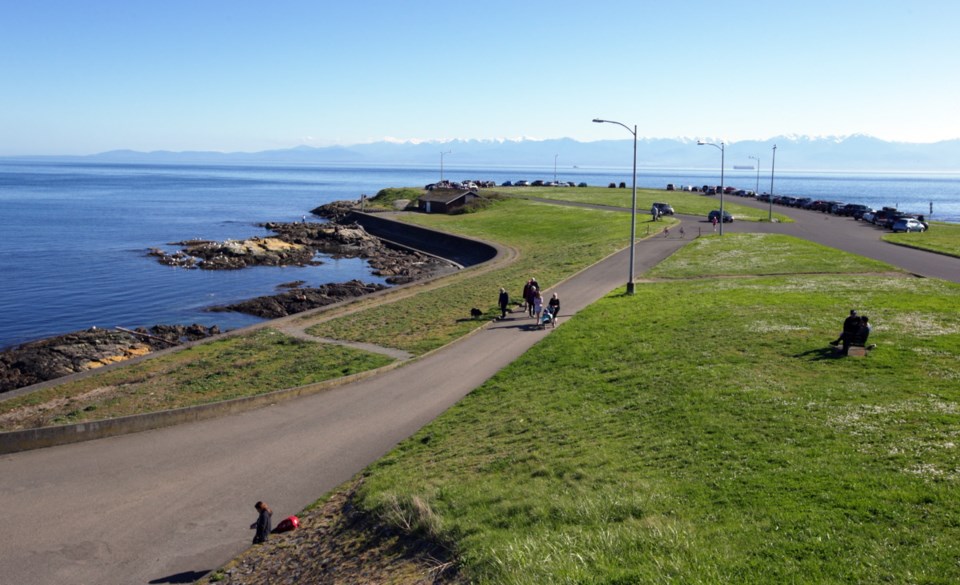Everything from dust to design will be under consideration as Victoria moves to develop policies for siting a sewage treatment plant in the city.
But Coun. Geoff Young says the city is putting the cart before the horse and by developing policies on how to site a treatment plant, it will be perceived as advocating for it rather than adjudicating whether it’s the right fit.
“No matter how many things we add [as conditions of approval], the city is going to be seen as the proponent of this proposal,” Young said.
Mayor Lisa Helps, however, said the hope is to put a set of principles into the process.
The Capital Regional District’s latest sewage-treatment plan has identified Victoria’s Clover Point and Esquimalt’s McLoughlin Point/Macaulay Point as sewage-treatment sites and has asked the two municipalities to consult their residents about the areas’ suitability.
City staff say regardless of where a plant is ultimately built, a set of policies is needed to determine the “suitability and appropriateness of a rezoning for this type of use.”
They note in a recent report to council that there are no expectations on what should be submitted by the CRD in terms of technical studies, supporting reports or engagement plans.
But rather than developing the policy, the city should focus on its role as an adjudicator of land use, Young said. When the CRD makes its proposal, city councillors should weigh its merits and then listen to citizens, “having them tell us whether this is an appropriate site,” Young said.
“We are leaping forward with this proposal to use one of our precious parks and take it out of the public use for two years and change it forever to have a facility that’s going to cost the people of the region a quarter of a billion dollars extra,” he said.
“Meanwhile, the municipality of Esquimalt has so far not agreed to allow a site on their disused tank farm 500 metres from the nearest residence outside the military base.”
If Clover Point were the only available option or even if it presented considerable savings, residents, even those living right across the street, might be willing to consider it, he said.
But that simply isn’t the case, he said.
In 2014, the CRD abandoned a plan that was estimated to cost $788 million for a single regional plant at McLoughlin Point because Esquimalt wouldn’t approve minor zoning variances. The current two-plant option is estimated at $1.13 billion.
“If people are in a situation where they are saying it doesn’t have to go [to Clover Point], it’s more expensive to put it there, there are no good reasons for putting it there, then there’s no degree of mitigation that can make up for what will be clearly significant impacts on the site,” Young said.
While the CRD’s current preferred option involves burying a tertiary treatment plant under the waterfront park at Clover Point, city staff say that plan could change, and regardless of the ultimate option chosen, there are any number of “considerations” that have to be addressed in locating a sewage-treatment plant, regardless of the site.
Those include: water quality and resources, odour, flood risk, seismic issues and sea level rise, site selection background, archeology and cultural significance, landscape and visual impacts, open space and green infrastructure, noise and vibration, cultural significance, traffic and transportation, air quality and emissions, dust, smoke and artificial light, waste management, socio-economic issues, architecture and urban design.
Once completed, the document would address: land-use suitability, siting options and considerations, designer requirements, construction and operational considerations, amenity priorities and opportunities, technical feasibility and cost-effectiveness to Victoria taxpayers.
Helps said principles have to be spelled out.
“Right now, the preferred site is Clover Point. The preferred site has been Rock Bay. This is plan amendment No. 10. We don’t know for sure where a facility will end up. We do anticipate there will be one in the City of Victoria.
“Right now, for anything to go ahead at Clover Point or anywhere else in the City of Victoria, it has to meet the needs of our residents and it has to meet … the technical feasibility,” Helps said.
Council approved the policy development and also directed that an open house be held April 25 to get feedback on the engagement strategy.
The target is for the policy to be completed by September, and staff suggest it might delay completion of the Fairfield-Gonzales neighbourhood plan.



